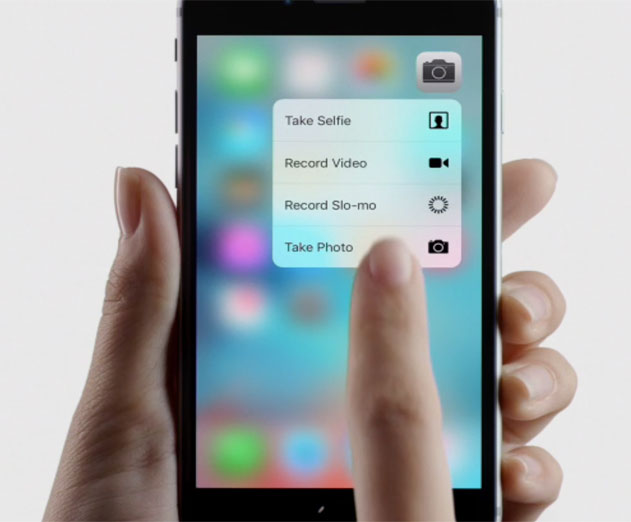Why 3D Touch is Going to Change the Way We Interact with Mobile
Wednesday, December 30, 2015

|
Richard Harris |
We recently visited with Michael Wass of Shinobicontrols to discuss the impact of 3D Touch on mobile app development. Shinobicontrols creates interactive UI controls for iOS and Android developers.
ADM: Why is 3D touch going to change the way we interact with mobile?
Wass: 3D Touch solves a lot of problems with mobile, and a lot of the inherent problems with iOS. Much of these issues revolve around how to be truly productive on a small device, with limited screen real estate- I refer to this as ‘the right click problem’. You don’t have a cursor on a mobile device so you can’t do the same things. Up until now, that’s just a compromise we’ve had to live with- 3D Touch changes that. We can now do more than one thing in a single interaction.
The second major change is that it’s kind of an evolution of the touch screen user experience, much in the same way that the leap from resistive touch screens on a Nintendo DS to the capacitive screen of an iPhone. When developers were able to think of new ways of having people interact, we got better software and it changed our expectations. 3D Touch has the potential to be as significant.
ADM: Do you think 3D touch will be widely adopted?
Wass: I think it will, but for a while it may be at the premium end of the market. If the chief benefit of 3D Touch is increased capacity for interaction and productivity, the user profile associated with that is more likely than not someone who owns an up-to-date smartphone. They have expendable cash, they choose the software they use based upon how reactive it is, how smooth it is.
There’s a reason why Apple still has an enormous app revenue lead over Google- those who can afford to pay more want that premium experience. Dealing with enterprise app developers for years, I’ve seen a repeating pattern- they want to do iOS first, then wrap that and move on to Android. The idea that this huge majority of Android phones being translated into Enterprise use is quickly becoming redundant. User Experience is just too important, and Apple still has that edge.
Android phones from Sony and Samsung will implement their own version, but I have a bias toward a consistent smartphone experience - one that evolves over time, rather than has drastic changes depending on what fork of the OS you’re using. I’m fairly confident that this will become a standard thing with smart phones over the next few years, whatever manufacturer or OS.
ADM: Why is 3D touch important for enterprise applications?
Wass: It’s important for a few reasons. Perhaps most significantly it increases the ceiling for user engagement within an app. We often preach the merits of a touch focused experience that’s not to say functionality is unimportant, because especially within enterprise apps it demonstrably is. 3D Touch removes the barriers to that extra functionality that we really do take for granted on our desktop devices.

Then there’s the fact that it’s a distinctly mobile experience. iOS is now designed with a concept of depth firmly in mind - this is perfect for performing analysis and diving deep into various forms of data. The layered design is not just decoration. Making data meaningful is what mobile can do better than desktop or web - connecting users to that meaning behind the data, providing insights which increase efficiency or expose process flaws.
If you want a short answer, just consider how much easier it is to push down harder to copy, paste or edit than it is to wait a few seconds in the awkward hope of expectation. This is a big deal for data entry and for accessing files within iOS’ equivalent of what we’d think of as a file hierarchy. Deep linking between apps facilitates a lot of sharing of data between secure apps on your smartphone - 3D Touch is the mechanism to get at that stuff without hassle.
ADM: You mention use case, do you have any examples you can share?
Wass: Here are three:
- Peek at a Sparkline and Pop to a Chart
- Adding an action through a pressure-gesture
- Change the visualization within the visualization
ADM: These are all finance applications, why have you picked this sector and can other enterprises adopt a similar approach?
Wass: We looked at Finance first because that’s our point of origin really, finance is usually a big first adopter of these kinds of technologies - look at NatWest and Touch ID, for example.
However it’s really a case of telemetry data, at least for us. We work with a lot of organizations who gather telemetry data from an operational perspective, and a lot who do it for consumer reasons. So there’s a range of verticals between Oil and Gas, the Wearables market and Healthcare, all the way to retail outlets who benefit from the insights that this kind of innovation grants access to.
ADM: How should developers react to 3D touch and what would you advise - would you advise them to incorporate it into their app straight away?
Wass: It largely depends on who your users are, but what we’re increasingly seeing is that the new stuff from Apple and iOS is adopted so rapidly that the days of lagging around three operating systems behind are numbered. Mobile iterates rapidly, it rewards people who adopt technologies early and refine it. There’s a chance now for developers to define a new language of user navigation - in the series I pointed to Pinterest as being a great example of a UI innovation that will probably become ubiquitous.
If you don’t have the capability to deploy the engineering capital to get it done right now, at the very least build it into your UX process - I believe there’s a very strong chance that 3D Touch is the solution to a lot of problems that mobile UX designers currently face.
Instagram have already taken this approach to their Android version. They don’t have 3D Touch equivalent technology but the interaction language is already proving to be popular enough that they’re rolling out an early mimic.
ADM: Is there any additional resources developers can take a look at?
Wass: We’ve finished our high-level, non-technical overview which we hope to turn into an eBook of some sorts soon. In 2016, we’ll be trying to introduce 3D touch within our already established product range, and we’ll be doing a technical series which aims to help developers actually implement our suggestions through demo apps, code samples and in-depth tutorials.
Those who are interested in the series can sign up to the mailing list. For now, we would recommend checking out the Apple documentation.
Editors Note: Michael has written a three part series titled “3D Touch & The Enterprise.” The three articles are (1) Examples for a new UI Paradigm, (2) User Navigation and (3) Data is a layered thing. The mailing list signup Michael mentions at the end of this article can be found at the bottom of any of the mentioned blog posts.
Read more: https://www.shinobicontrols.com/

Become a subscriber of App Developer Magazine for just $5.99 a month and take advantage of all these perks.
MEMBERS GET ACCESS TO
- - Exclusive content from leaders in the industry
- - Q&A articles from industry leaders
- - Tips and tricks from the most successful developers weekly
- - Monthly issues, including all 90+ back-issues since 2012
- - Event discounts and early-bird signups
- - Gain insight from top achievers in the app store
- - Learn what tools to use, what SDK's to use, and more
Subscribe here




_cptybzmh.jpg)








